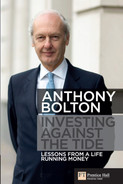Introduction
I began writing this introduction at 36,000 ft on a Boeing 777 on my way to the Caribbean. It’s December 29 and the markets have almost closed for 2007; only Monday December 31 remains and I am one day away from giving up the Fidelity Special Situations Fund, the fund I have run, day in, day out for twenty-eight years. This marks my retirement from active fund management and stock-picking. It’s a strange feeling – an activity that has occupied some point of my every waking day for those twenty-eight years and the two to three years before this that I ran money. Although I am resolved that this is what I want to do creating more time for my other interests, there is a bit of me that’s sad. That said, I will not miss the daily mounds of information that a fund manager these days has to absorb – the reports, the emails, the voicemails, the meetings, the interactions with a team of more than thirty managers and sixty analysts. I can’t quite believe I won’t have to read another company’s preliminary statement, examine a balance sheet, take notes of what another chief executive tells us, discuss the best ideas of an analyst or send another trade to my trader. In fact, I’m sure I’ll still be doing some of these things in the future. However, one thing that I really want to do is to try and pass on the essence of what I’ve learnt over the past thirty years or so, first to my colleagues – and this will be my most important activity over the coming year or so – but also to a wider audience, hence this book. A lot of the material here is based on discussions that I’ve had with my investment colleagues at Fidelity and I have already used much of the book’s contents to help train our analysts and new fund managers. Although the first book that Jonathan Davies and I wrote contained some explanation of my investment approach, my aim here is to expand on what I’ve learnt in much more detail. This book is aimed at both professional investors and the more sophisticated amateur investor, although I hope much of it will be of interest to most private investors.
There is very little that’s new in investment and I will refer to important things I have learnt from other investors and quote widely from them (and I hope I’ll be forgiven if I say something here someone else has already said and not given them credit). The quotes I have chosen are ones that I have found particularly useful in running money. What is original is the way I have blended all the ingredients together. As the accomplished investor Nils Taube (who sadly died while I was writing this book) once said, plagiarism is the key to good investing – and I fully agree with him. Investing is such a beguiling activity – it appears so easy at first; but if you talk to most professional investors they will admit to finding it harder than they thought it would be. Also, I have seen many bright, hard working and dedicated individuals that would normally succeed at whatever they put their hand to fail at investment. Why? It is much more difficult than it appears, particularly to do well consistently. Buy low/sell high is not easy.
I have called this book Investing Against the Tide to reflect my contrarian approach to investment, being happy, and often more comfortable, swimming against the prevailing flow. It is organised into two main sections. The first is called ‘Principles and practices from a life running money’. In this part I look at what makes a good company; how we go about company meetings; how I evaluate managements; how I look at shares; the importance of sentiment; and how to put shares together in portfolios. I go on to discuss company financials, balance sheet risk and my biggest mistakes, valuation techniques, mergers and acquisitions, recovery stocks, trading and how to use technical analysis. I then look at information sources, using brokers, market timing and macro factors, some observations on fund manager performance and which twelve attributes, in my view, make a good fund manager. In part 2, called ‘Experiences and reflections from a life running money’, I discuss some of my more interesting meetings, my best and worst investments as well as how the business has changed during my time in it. I end with some final observations on the investment business.
At the beginning of the book is a letter about Mr Johnson’s (Fidelity’s founder) views on investment stars, which I believe sums up some of the unique qualities of Fidelity as an organisation. I also list my portfolio assignments.
Although, as I say, I hope I have written the book in a way that an experienced amateur investor will derive something from it, I’m afraid at times the jargon may let me down, even though I have tried to avoid this and to give explanations wherever possible. On the other hand, this is not meant to be a textbook in the sense that it will contain detailed definitions of terms such as cash flow or enterprise value, so I assume knowledge of these.
Later in the book I go into much more detail about what makes a good investor; although the longer I’ve been in the business the longer I particularly value two attributes – common sense and temperament. If you can think logically, objectively and independently and ‘keep your head when others are losing theirs’, you have the starting blocks to being a successful investor.
Anthony Bolton
